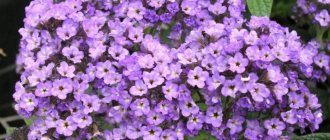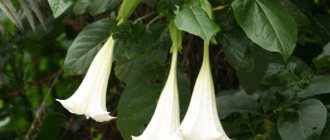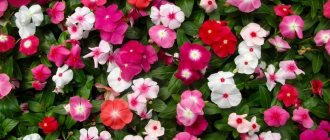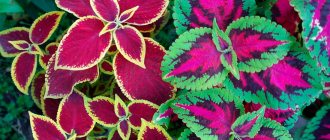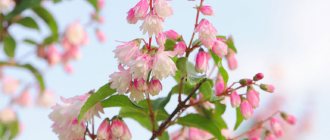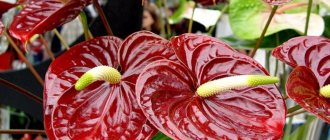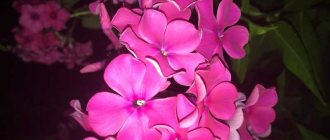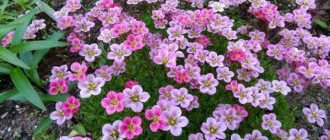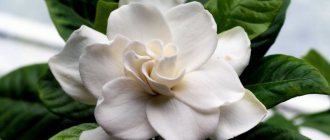The flower is native to South and Central America. Belongs to the merlin family. Considered evergreen, it blooms in warm summers. For its unusual flowers it received the name cigarette tree. Translated from Greek it means “crooked”.
It is a bush or ampelous plant with curved, narrow-shaped leaves. It can reach 1 m in height. Flowers have a variety of sizes and colors. Large-flowered ones bloom quickly, small ones bloom longer and more.
What does kufeya look like?
Kufeya is an evergreen shrub with a lush fan shape. The plant belongs to the Derbennikov family. The shoots of the flower are erect, the leaf is of medium size, and is colored rich green.
Kufeya in landscape design
The cuphea flower is of Mexican origin. But the name has Greek roots and means “bend”. Externally, the plant fully corresponds to its name; the leaves of the kufei have obvious curves. It is generally accepted that if this plant blooms in a house, then peace and mutual understanding reign between the residents. For this reason, the flower is often placed in hotels, meeting rooms or other work spaces.
Important! The peculiarity of kufei is its inflorescences - their tubular shape resembles a cigarette with a smoldering tip.
This feature can be explained by the fact that in their homeland, kufeya is pollinated by the smallest birds in the world with a thin, curved beak - Hummingbirds. The plant blooms magnificently; this period lasts from spring until autumn. Throughout the warm period, houses, plots and window sills are decorated with magnificent kufei flowers.
Common types and varieties
The genus Kufei has more than 250 species, so you shouldn’t be too surprised if you see completely different plants under this name. Perennials can be not only of the bush type, but also of the herbaceous type, with erect or climbing stems. In Russia, they usually grow certain varieties that do well in any type of container.
Kufeya issopolis
Heuchera: planting and care in open ground
Kufeya issopolis is a species that has a special fresh appearance. These bushes reach half a meter in height.
The shoots actively branch, the leaves are small, the length does not exceed 3 cm, and are bright green. For kufei, such flowers are completely atypical.
The color of the inflorescences is lilac-pink, the petals are the same size, and there is a corolla with a diameter of 1 cm in the middle.
Important! These inflorescences do not produce seeds, so they can only be propagated by cuttings.
Kufeya Dynamite
Kufea Dynamite is a variety of hyssopolis kufea. This bush can be easily shaped by pruning to create the desired shape. For this reason, in addition to growing in containers, they prefer to plant the plant in open ground.
Abundant flowering in the warm season can truly decorate any, even the most unattractive, area. The shrub prefers warm weather, but winds and rains are not particularly scary for it.
Kufeya fiery red
In indoor conditions, the plant's growth reaches 40 cm, its stems are quite plastic. You can form it into an ampelous plant or a bush. The leaf has a smooth surface, elongated and narrow shape.
The inflorescences are elongated bright red tubes. At the end of these flowers there is a black-purple petal. Not only thanks to its inflorescences, but also to its unpretentious properties, the plant has taken root well in indoor cultivation.
Fiery red kufeya
Kufeya Gelya
This variety belongs to the fiery red variety. External data attracts many gardeners.
In a container, this plant grows beautifully and decorates balconies, loggias, offices and other rooms. Not only in containers, but also in flower beds, the kufeya variety Gel feels great. The plant can be planted in personal plots; it is usually used to decorate borders.
Description
Translated from Greek, kufeya means “crooked”; it is believed that the plant got this name because of the fruits, which have a curved shape. Kufeya is a compact ornamental plant. It owes this to its strong stem, to which many small leaves are attached; they have an oblong and solid shape, and their tops are pointed towards the edge. The flowering period of kufei is considered to be the beginning of the spring season, and it lasts until mid-autumn. The gaps between the leaves are filled with gorgeous inflorescences, which give a special charm to the plant. Basically, the flower cup consists of 6 petals and has a porous structure. The color range of flowers is quite varied. Most varieties of kufei are not replete with contrasting shades, but, on the contrary, are painted in delicate tones.
The culture is ideal for planting in open ground and looks good as a houseplant. Kufeya is usually cultivated as an annual plant when it comes to planting in the garden. The plant can survive the winter season only if it grows in the southern part of Russia. Some varieties of flowers can withstand up to 12 degrees below zero. It can be grown indoors for several years. The main difficulty in growing such flowers in our area seems to be the heat-loving nature of kufei. It is best to grow them in flowerpots or any other containers.
In the warm season, such a plant can be used to decorate a garden or balcony, and with the onset of cold weather, it can be placed again in a warm indoor environment.
Botanical description
Cuphea or Japanese myrtle is an annual and perennial herbaceous plant, as well as shrubs, belonging to the family Derbennikov. In the natural environment, these interesting and unusual plants are common in temperate, tropical and subtropical climate zones of America (southern and central parts).
The name of the plant comes from the Greek word “kyphos”, which means “crooked, bent”. After the end of flowering, curved fruits are set; most likely, the name of the plant was given due to this.
Kufei has a compact appearance. The stems are erect, dotted with small oblong leaves with entire edges and sharp tips.
When does kufeya bloom?
The flowering period of kufei is long: it begins in early spring and lasts until October. There are as many inflorescences as there are leaves, but they do not compete with each other, but only complement each other, the bush becomes exquisite and very elegant.
The flowers are tubular in shape, with six petals in almost all species (the upper two petals are usually larger in size). Modest flowers can be white, pink, lilac, red. It’s as if nature specially created kufeya for lovers of meditation - the plant does not have huge inflorescences or “screaming” forms; admiring the plant, the soul is filled with peace and tranquility. By the way, the stems of the plant are a little sticky; if you plant tall bushes around the perimeter of the plot, you will protect your yard from the unceremonious invasion of your neighbor’s pets.
Frost resistance of kufei
Kufeya is simultaneously among the indoor and garden plants. In the conditions of central Russia, annual species and varieties are grown seasonally in open ground, and perennials are cultivated as indoor plants. Flowerpots with flowering bushes become decorations for the garden, veranda, and balcony during the warm season. In October, bring the containers with the plant into a cool but closed room, and when frost sets in, return them to their usual place (in the room). Kufeya is capable of wintering in open ground only in the southern regions of the country. The most frost-resistant varieties can withstand a maximum of 12°C below zero.
Even in its homeland, kufeya became popular in gardening some 15 years ago. In Arizona, in the late 80s, active work began on breeding new interspecific hybrids, but the results of their work have not yet reached European countries. Growing kufeya is not difficult, but due to its heat-loving nature, it has its own difficulties.
Kufeya: planting and care in open ground
When it comes to planting in the garden, in Russia kufeya is usually cultivated as an annual plant. Because the roots can survive the winter season only if the temperature does not fall below -12 degrees. It is clear that the conditions of the Moscow region are in no way suitable for planting perennial varieties - winter will destroy the roots. But in the south of the country it is quite possible to try planting kufeya in the ground for several years.
- Choosing a landing site
Monarda - planting and care in open ground
When planning to grow kufeya in the garden, you need to choose an open, well-lit area. Unlike other ornamental crops, this flower tolerates direct sunlight.
- Planting in open ground
The plant is planted by transferring it into pre-prepared holes (humus must be added to them and dug well).
Allowable distance between individual bushes: at least 30 centimeters.
- Watering garden kufei
You need to make sure that the soil does not dry out.
The plant likes daily evening watering, when the sun is no longer hot, but has not yet set.
Attention! If you water flower bushes after sunset, rot may appear.
- Need for fertilizers
If, when planting a plant in open ground, organic matter was added to the soil, then fertilizing may no longer be carried out. If, for some reason, the planting holes were not properly prepared, then fertilizer will need to be added for abundant flowering.
A couple of weeks after planting, they are fed with nitrogen fertilizers. When the buds begin to form, it would be good to add phosphorus-potassium substances.
Landing algorithm
With any method of growing kufei seedlings, the time for taking them out into the open air does not occur until the threat of night cold snaps has passed. The heat-loving crop does not tolerate not only frost, but also significant fluctuations in day and night temperatures.
In warm climates, kufeya is planted in flower beds by mid-May. In the middle zone and further north, seedlings can be transplanted into pots or cache-pots and placed in the garden or terrace only for the summer. In climates where kufeya freezes in winter, it can be used as an annual, and in the fall, collect seeds from the plant or cut cuttings.
Rules for planting kufei:
- Flowerbeds for culture are prepared in advance. At the time of planting, the soil should be quite loose.
- The distance between seedlings or rooted cuttings is left at least 30 cm.
- The holes are made a little deeper and wider than the root ball of the seedlings. It is useful to add a handful of wood ash to the bottom of each.
- For perennials, arrange a drainage layer, then sprinkle a little humus, and a thin layer of garden soil on it.
- The seedlings are carefully removed from the glasses, trying not to damage the roots.
- Place the plants in the holes, add the missing soil, and then water the area generously.
If desired, in the fall, the kufeya can be dug up along with the roots, transplanted into a large pot and grown as a houseplant until spring. With the onset of warmth, such a bush is rejuvenated by pruning, and in the summer it is again taken out into the open sky.
Kufeya: features of care at home
This plant can be called truly demanding and capricious. For this reason, if novice gardeners get down to business, growing and caring for kufei often brings complete disappointment. If basic care rules are not followed, the leaves of the flower will immediately begin to turn yellow, after which they will fall off and the bush will become bald. With poor care, flowering is difficult to achieve, and it will not be as abundant as we would like.
- Temperature
Nasturtium planting and care in open ground
The plant loves warmth, but in moderation; it needs normal air heating.
In summer, the temperature should not be higher than 25 degrees, and in winter, when the rest period begins, around 19-20 degrees Celsius.
- Lighting
In order for the bush to develop vegetatively according to all standards, it needs a normal amount of sunlight.
It is best to place the container with the plant on the east side of the house. Western windows are relatively good; wintering on them is acceptable.
Important! Growing on northern windows is unacceptable - due to the lack of sunlight, flowering will be poor and the leaves will become dull.
- Watering
At any time of the year, watering kufei as care at home is the same. The plant prefers a good amount of moisture every 3 days. Between waterings, do not allow the substrate to dry out completely. The flower tolerates drought normally only in open ground conditions.
- Spraying
You can and even need to spray kufeya. The flower needs irrigation at least 3 times a week. The description of the variety speaks of its special love for humid microclimates.
Growing kufei in a container
- Humidity
The plant loves high humidity levels. For this reason, you should not keep it in a room with dry air, and if there is no other option, you should take care to spray the plant frequently.
- Priming
The soil should be nutritious and well drained. A store-bought mixture with weak acidity is quite suitable.
- Feeding
Fertilizers should be applied once every 2 weeks. Complex preparations with fluoride and potassium are suitable.
Lighting and temperature conditions
In summer, kufeya needs moderate temperatures. It is best to expose indoor plants outdoors in the summer.
In winter, you will feel best in a cool room (at 15–18 degrees). But it will tolerate lower temperatures of up to 8 degrees without any problems.
Bright places are preferred for this plant Some types of kufei even need direct sunlight. When growing at home, the ideal place would be eastern windows.
But if this is not possible, then the plant can grow on a western window . You should not place kufeya on northern window sills; a lack of light will lead to poor or no flowering.
When and how does kufeya bloom?
The flowering period of kufei can be quite long if all the rules of agricultural technology are followed. Good care will give abundant flowering.
- Types of flowers
The appearance of the flowers depends entirely on the type and variety of kufei. The corollas can be painted not only brick red, but also creamy white.
Important! Red flowers are the earliest to form.
- Flower shapes
The shape of the flowers is tubular with a dark tip; it is the most common and resembles a kind of light. The second most popular form is an inflorescence with petals of the same size and a pronounced pistil.
- Flowering period
This plant blooms from March to October. For almost six months, the plot or loggia will be decorated with beautiful flowers.
- Changes in care during the flowering period
During the growing season, pruning should not be carried out under any circumstances. Watering is reduced slightly, but the soil should not be allowed to dry out. Don't forget about applying fertilizers.
Attention! You should not use formulations with a large amount of nitrogen, otherwise only the green crown will actively grow.
Pruning kufei
Pruning must be done every spring. At this time, it will be possible to give the crown a good shape and the desired size.
- The fiery red kufeya needs to be pruned so as to shorten only the long branched shoots.
- Kufeya hyssopolis will have to be shaped much more carefully to make an attractive crown.
In the last days of March, 2/3 of the shoots should be removed, this is how growth and vegetation are stimulated.
Formed kufei bush
How does kufeya reproduce?
Kufeya propagates using cuttings and seeds. If any of the propagation methods has produced a strong and healthy plant, it can be safely planted in open ground.
Germination of seeds
Instructions for sowing seeds:
- The seeds of the plant are stiff and have poor germination. The seed material is laid out on the soil surface. You don’t need to cover them with soil, you can just press them a little into the ground.
- The containers must be covered with film and placed in a warm place.
- Abundant but infrequent watering is carried out.
- Picking should be carried out after the appearance of the fifth leaf.
Rooting cuttings
It is better to cut cuttings for propagation in late spring. They can be successfully rooted using phytolamps.
The main thing is that there are at least 2 nodes on the cutting. To begin with, the cuttings are planted in sand and the container is covered with film. Don't forget about watering.
After rooting, the cuttings can be safely planted in different containers.
Air layering
Those varieties of kufei that have air layering can be propagated with their help. To do this, it is important to cut off the desired area of the shoot, treat it, moisten it and wait until roots appear in this place.
The cuttings are cut at a distance of 1.5 cm below the cuff and planted in the substrate.
For reference: this method of propagation is practically not used for kufei.
Reproduction
Kufeya is propagated in two ways.
For cuttings, select semi-lignified roots larger than 7 cm in size. They are processed and planted in prepared soil made of peat, turf, humus, leaf soil, sand (1: 1: 1: 1: 0.5).
Conducted in the spring, when the air temperature rises above +15…+18 ºC.
When planting, create greenhouse conditions, regular watering, and ventilation. To make the flower look beautiful, several cuttings are connected together. After the 3rd pair of leaves emerge, pinch off the top.
The second method is propagation by seeds. The conditions for planting are the same as for cuttings. The seeds are not sprinkled with soil on top. When small sprouts sprout, they are placed in small cups.
Possible problems in growing kufei
If you follow all agrotechnical rules for growing kufei, no special problems should arise. But if care does not meet the requirements, the flower begins to give signals, its external characteristics become unattractive.
Yellowed leaves
- Drops buds and leaves
This reason may occur due to insufficient sunlight. At best, flowering will be sparse; at worst, the plant will independently shed the established buds.
- The leaves are turning pale
If the leaf turns pale or yellow, there are two solutions to the problem. In this case, it either lacks iron, or the watering was carried out too abundantly or often. It is worth reducing watering and adding the necessary fertilizers.
- The tips of the leaves are drying out
In this state of affairs, we can talk about insufficient watering, or the presence of strong drafts. It is necessary to increase watering, after it there should be water left in the pan, after 10 minutes it needs to be drained. If drafts are a concern, it is better to move the pot to another place and carry out sanitary pruning.
- The lower leaves fall off
In addition to the falling of the lower leaves, they may also become covered with brown spots. Most likely, the root collar is rotting. The plant suffers from a fungal disease; urgent treatment with fungicides and sanitary pruning are required.
Pests
In rare cases, kufei is attacked by scale insects and spider mites. If there are mites in the container, then a characteristic thin white web can be observed on the plant. In such a situation, it is enough to treat the plant with a sponge soaked in a soap solution. If the case is advanced, then chemical treatment will be required.
If convex brown tubercles are found on the leaves, then we can talk about the appearance of a scale insect. A soap solution and a brush will help mechanically get rid of such insect shells. Additionally, insecticidal treatment can be carried out.
Kufeya in the garden
If you properly care for your exotic kufeya, no problems should arise with it. Beginner gardeners should not take on growing a flower; they may not be able to cope with this plant, because caring for it is not so easy. We must not forget about watering, fertilizers and mandatory pruning, then for many months you can expect beautiful flowering of the shrub.
Diseases and pests
The flower is not prone to pest infestation , however, spider mites or scale insects may appear on it.
When damaged by spider mites, a thin white cobweb forms on the leaves.
At the initial stage, it is enough to carefully wash the plant with a soft sponge and soapy water.
In neglected form, after washing, you will still have to spray with chemicals.
When scale insects appear, brown protuberances, which are the shells of these insects, are clearly visible on the leaves.
To combat it, you need to wash all the leaves on both sides with a brush and soapy water, mechanically removing the pest. If necessary, after this you can still treat with insecticides.
The appearance of gray spots on the leaves and rotting of the stem is the result of the appearance of fungi and gray rot. It is necessary to treat the plants with fungicides against rot.
Attention! Being in a draft can cause leaves to drop.
For everyone who is interested in growing the most unusual plants, we have prepared a series of articles on caring for Metrosideros, Palisota, Homalomena, Hypocyrta, Radermachera, Mühlenbeckia, Polyscias, Leptospermum, Colocasia and Dizigotheca.
